#Revive Essential Oils
Explore tagged Tumblr posts
Text
Creating a Safe Haven: The Importance of Natural Cleaners in Our Homes
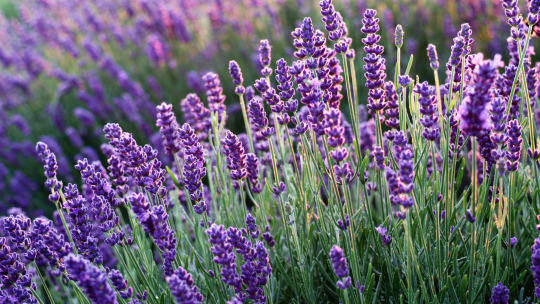
Hello dear homemakers and health enthusiasts! Today, let's dive into a topic that's close to my heart as both a homemaker and a naturopathic geek: the importance of using safe and natural cleaners in our homes. In our quest to create a clean and welcoming environment for our families, it's essential that we prioritize not just cleanliness, but also the health and well-being of our loved ones. Let's explore the impact of conventional cleaning products on our health, particularly on cognition and toxicity, and discover the transformative power of natural alternatives.
First and foremost, the hidden dangers lurking in many conventional cleaning products. From harsh chemicals and synthetic fragrances to toxic fumes and irritants, these products can wreak havoc on our health, compromising indoor air quality and posing risks to our respiratory system, skin, and overall well-being. But perhaps most concerning of all is the impact of these chemicals on our children, who are particularly vulnerable to their effects.
You see, kids have a knack for getting into everything—including cleaning products. Whether it's curious toddlers exploring under the sink or adventurous preschoolers mistaking colorful bottles for toys, the risk of accidental ingestion or exposure to harmful chemicals is all too real. And the consequences can be dire, ranging from mild irritations and allergic reactions to more serious health issues such as respiratory problems, neurological effects, and even poisoning.
But fear not, dear friends, for there is a solution: the transformative power of natural cleaners. By harnessing the cleansing power of nature's bounty—think vinegar, baking soda, essential oils, and plant-based detergents—we can effectively clean our homes without compromising our health or the environment. These gentle yet effective alternatives not only leave your home sparkling clean but also provide peace of mind, knowing that you're creating a safe and healthy haven for your family to thrive in.
Moreover, natural cleaners offer a myriad of benefits beyond their safety profile. They're environmentally friendly, biodegradable, and free from harmful chemicals and toxins, making them a sustainable choice for eco-conscious homemakers. Plus, they often boast antimicrobial, antifungal, and antibacterial properties, helping to combat germs and pathogens without the need for harsh chemicals or synthetic additives.
Let's make a pledge to prioritize the health and safety of our families by embracing the transformative power of natural cleaners. Let's banish harmful chemicals from our homes and replace them with gentle yet effective alternatives that nourish both body and soul. Together, we can create a clean, welcoming, and truly safe haven for our loved ones to thrive in. Here's what I'm using and loving here in the cozy little cabin.
Here's an amazing recipe I created to make your own homemade cleaner at home:
Lavender Lemonade Sparkle Spray:
Ingredients:
1 cup distilled water
1/4 cup white vinegar
10 drops lavender essential oil
5 drops lemon essential oil
1 tablespoon witch hazel
1 teaspoon liquid castile soap
Instructions:
In a clean spray bottle, combine the distilled water and white vinegar.
Add the lavender and lemon essential oils, along with the witch hazel and liquid castile soap.
If desired, add a splash of rubbing alcohol for extra cleaning power and sparkle.
Secure the spray bottle cap and shake well to mix all ingredients thoroughly.
Your Lavender Lemonade Sparkle Spray is now ready to use! Simply spritz onto surfaces and wipe clean with a cloth for a fresh, sparkling finish that leaves behind a delightful aroma of lavender and lemon.
Enjoy the unique blend of calming lavender and refreshing lemon as you clean your home, turning chores into a fragrant and uplifting experience.
Enjoy!
Love, Kimmi
#homemaking#homemaker#homemakers#housewife#natural cleaners#natural living#essential oils#oils#essential oils at home#essential oil#revive essential oils#selfimprovement#housewife tips#homemade cleaners
5 notes
·
View notes
Text
0 notes
Text
Embracing Change: Why I Transitioned from doTERRA to Revive Essential Oils

Today, I come to you with an open heart and transparency as I share a significant shift in my journey with essential oils. After much reflection and careful consideration, I made the decision to stop selling doTERRA oils and embrace the transformative power of Revive Essential Oils. Join me as I delve into the reasons behind this transition and invite you to explore the remarkable benefits of Revive oils through a captivating video at the bottom of this page.
For three years, I proudly represented doTERRA and shared their products with enthusiasm and passion. I believed wholeheartedly in the quality and efficacy of their oils, and I witnessed firsthand the profound impact they had on the lives of countless individuals. However, as time passed and I delved deeper into the world of essential oils, I began to question certain aspects of the business model and intentions of doTERRA.
One of the initial, primary factors that prompted my decision to part ways with doTERRA was personal. Moving away from a company that I could no longer believe in, or support or be supported by financially was difficult to say the least. While I firmly believe in the value of high-quality essential oils, I always said that I would seek truth and good morals in any company that I choose to do business with. I just couldn't stand by their company anymore.
Enter Revive Essential Oils—a game-changer in the world of aromatherapy and wellness. With a commitment to transparency, integrity, and affordability, Revive offers a wide range of high-quality essential oils that rival the efficacy of top brands like doTERRA at a fraction of the cost. In fact, in some cases, Revive oils are nearly half the price of their counterparts, making them accessible to a broader audience without sacrificing quality.
I'm so excited about this new chapter in my journey with essential oils and I invite you to join me in embracing the transformative power of Revive. Let's open our hearts and homes to the healing benefits of affordable, accessible essential oils. Working with an honest company is defiantly a bonus!
Click this link if you want to try them out and compare them to other companies.
Click the link above to watch the video and discover why I'm so passionate about Revive Essential Oils.
#naturopathy#healthy lifestyle#wellness#reduce stress#doterra#reviveessentialoils#essential oils#revive essential oils#health and wellness#restoration wellness#pure oils#essential oil#essential oil companies
1 note
·
View note
Text
the way house of leaves has been revived for a cult following is so funny. it's completely backwards! it was a music industry book. the singer poe, who made waves with her debut for having a few tracks produced by j dilla and then if i remember correctly doing a 500+ show tour, essentially tanked her career to promote the book (written by her brother)
not like on purpose but it was supposed to be a paired project and there was a remix with a book excerpt read by mark (the kyrie bmw sex scene) and like, i don't know, a tie-in website -- but then her label got sold or merged or acquired and the project was eventually cancelled after languishing in limbo for a few years. there's also an aspect of this where like, a texas oil executive posed as a friend of her late father (possibly true) in order to manipulate legal proceedings (?) to ultimately own her writing and recording copyrights post-acquisition (dubious allegation, which also relies on her having signed away both types of copyright to her label in the first place, arguably a larger problem spanning the whole industry, even today, still coming up in legal proceedings from kesha and taylor swift and so on)
anyway the album (haunted) and the book were both inspired by the same event (death of their father, tad danielewsky -- as an aside, a professor of theater at brigham young university). the album features samples from a box of cassette tape recordings of his voice. and also some fake samples from a couple of guys pretending to be tad danielewski with an obviously ridiculous accent and a couple of kids pretending to be her as a kid. and it takes place inside the house. the growl is there and everything i swear
it really was one of the top tier 90s concept albums (it was released in 2000 actually) but it is usually FAR too much to handle for casual listening and a lot of it comes across difficult for being so sincere and so unfocused (it is a love letter to her dead father where one of the songs is a list of places she's gotten fucked, because, uh, this is a conversation she wanted to have with him. shrug). and yet it's hard not to take it as it is because it's so consistently well produced
so i know nobody's computer comes with a cd player anymore but to read the book without listening to the paired album implicitly packed in the back of the book jacket is kind of like missing the whole point. there's a whole second act of rashomon you guys are missing. and a third act hello the etsy teleplays. ANYWAY the point i wanted to make is that there are a couple of things about the album sticking to the roof of my mouth as being somehow prescient. there's a distorted "why (are you) so serious" sample that would have come across VERY differently post-joker, but there's also "tell me something dangerous and true," a far more interesting variation on the theme currently circulating. and i'm speaking to an empty room here because it's only the celibate 60% of this website who is reading the book because it allows them a patina of literary validity and several nested unreliable narrators to distance themselves from the sex scenes, but haunted is very authentically, directly and exclusively written in first person and to be honest it fucks too hard for you guys. i'm sorry
778 notes
·
View notes
Text
In 2025, we will see a fundamental transformation in the language of climate politics. We’re going to hear a lot less about “reducing emissions” from scientists and policymakers and a lot more about “phasing out fossil fuels” or “ending coal, oil, and methane gas.” This is a good thing. Although it is scientifically accurate, the phrase “reducing emissions” is too easily used for greenwashing by the fossil-energy industry and its advocates. The expression “ending coal, oil, and methane gas,” on the other hand, keeps the focus on the action that will do most to resolve the climate crisis.
This discourse shift has been initiated by the latest report of the United Nations Intergovernmental Panel on Climate Change. The world’s climate scientists say that already existing fossil-energy infrastructure is projected to emit the total carbon budget for halting global heating at 2 degrees Celsius over preindustrial temperatures. This statement means two things. It means that the world cannot develop any more coal, oil, or gas, if we want our planet to remain relatively livable. And it means that even some already developed fossil-fuel deposits will need to be retired before the end of their lifetime, since we need to leave space in the carbon budget for essential activities like agriculture.
The international community has already integrated this new science into its global climate governance. The 28th Conference of the Parties—the annual conference of the world’s nations party to the United Nations Framework Convention on Climate Change—called for every country to contribute to “transitioning away from fossil fuels.” Never before in the history of international climate negotiations had the main cause of global heating been clearly named and specifically targeted. The United Nations itself now calls for the phaseout of coal, oil, and methane gas.
This new climate language will become mainstream in 2025. In her policy plans for her second term aspPresident of the European Commission, Ursula von der Leyen pledged not to work to lower EU emissions, but to “continue to bring down energy prices by moving further away from fossil fuels.” The new UK government promised in its manifesto that it will withhold licenses for new coal and for oil exploration—and states outright that it will “ban fracking for good.” And in France, Macron has explicitly vowed to end fossil-fuel use entirely.
Climate politics in the US will also evolve in the wake of Donald Trump’s reelection for president. Republicans will continue to embrace a “drill, baby, drill” climate agenda, denying the danger or sometimes even the reality of climate change while advocating for expanding domestic crude and methane-gas production. They may try to greenwash their policies by claiming they embrace an “all of the above” energy strategy, but this messaging will have limited effects. Due to political polarization the association of Trump with coal, oil, and gas will raise Democratic support for phasing out fossil fuels. Before the 2024 election, 59 percent of Democrats said climate change should be the Federal government’s top priority, but only 48 percent said they supported a phaseout. In 2025 majorities of Democrats will begin to support fossil-fuel phaseout, especially if climate advocates revive science-based climate messaging, continue to emphasize that clean-energy deployment is job creation, and frame choosing to phase out fossil fuels as a form of freedom that upholds our right to a livable future.
Given that Democrats won many down-ballot races, and cities and states are still pledging to pass climate policies, this shift in the Democratic majority will keep the US on the map in international climate negotiations, whether or not Trump withdraws the US from the Paris Agreement, creating new local alliances with the UK, the EU, and global south nations calling for international fossil-fuel phaseout targets. This bloc can counter the power of petrostates in international climate negotiations. At the very least, the mainstreaming of the language of fossil-fuel phaseout will help undermine the greenwashing strategy of current oil and gas company PR, which falsely advertises industry as pursuing technologies at scale to help “reduce emissions” even as they continue their upstream investments.
Of course the petrostates, along with India and China, will push back against the rhetoric of fossil fuel phaseout. But India can be helped to turn away from its domestic coal stores by clean-energy financing at close to cost along with the international aid and technology transfers already pledged at previous climate conferences. And although its rhetoric may not align with that of the West, China should not be imagined as opposed to climate action. China has enacted the most comprehensive climate policy on the planet, in service of its goal to peak emissions by 2030 and achieve net zero emissions by 2060. If their climate messaging remains focused on “emissions,” in light of their plan to keep using fossil fuels past 2030, they are preparing for next decade’s pivot away from fossil fuels by building out clean energy at a truly extraordinary rate.
In 2025 climate discourse will recenter on the message that halting global heating requires the phaseout of coal, oil, and gas. This new consensus will shift the politics of climate change and help motivate an urgent sprint to a clean-energy, ecologically integrated economy—the only economy that ensures a livable future.
55 notes
·
View notes
Text
Alastor - Historical Trivia And Headcanons

Alastor was a mixed-race Creole man living in New Orleans, and was in his 30's/40's when he died in 1933. We don't know much else about him, but historical context can provide us with possible additional details:
The population of New Orleans in 1930 was 458,762, more than it is now. 27.2% of the people were black, 3.1% were foreign-born, and roughly half of America's bipoc population was unemployed thanks to the Great Depression. New Orleans' original Francophonication was still strong, and it was common to run into locals who only spoke French dialects (Cajun French, Louisiana Creole). The city has had a huge Chinatown, a small Little Italy, and multiple other districts known for their immigrant African/colonized French cultures.
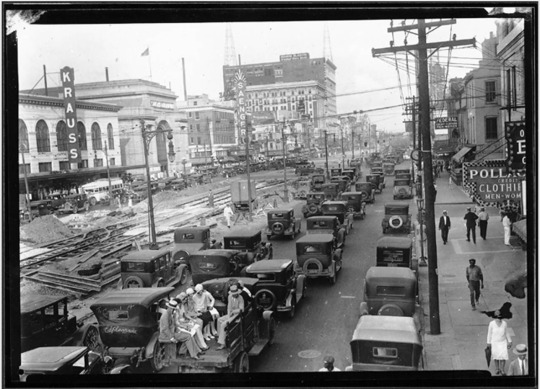
The Jim Crow laws were heavily enforced, as was the 'One Drop' rule. If Alastor was a mixed race black man, he would not have been able to attend a white school, use the same public transport, and would have shopped at black-local stores and restaurants under threat of violence. If he was mixed with any other race, some Jim Crow laws didn't apply, but state or city laws might specify differently.
Just because Alastor wears a suit, it doesn't mean he was rich in life. Radio personalities often didn't earn a fortune. Unless he owned his own broadcast, he was paid by a private company for long shifts of hosting music, news, and radio plays. In 1930, 40% of households owned at least one radio, which means that a popular radio host would have been easily recognized.
If he was in his late 30's in 1933, he might have fought in WW1, so long as he was over the age of 21. Some cities gave veterans small benefits, or encouraged the community to give them jobs. This often did not include veterans of color.
New Orleans was famous for being one of the least Christian cities in America, thanks to its unique immigrant and slave population. Haitian-based faiths and practices (such as voudo), indigenous cultures, Asian Buddhism, and atheism were common. But Christianity was still the official, law-enforced religion. Schooling involved reading the Bible, laws were sworn to Jesus, etc.
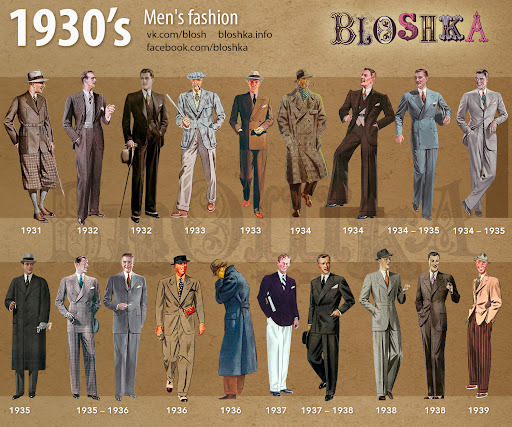
Alastor's outfit in Hazbin Hotel isn't very accurate to real-life American men's fashions of the time. Back then, deviating from the norm with the smallest detail would have stuck out like a sore thumb - like his white-lined lapels. Men always wore a hat. They were allowed to go without a waistcoat, but not a jacket. Belts were becoming more popular than suspenders. The silhouette was bulkier than the slimmer, Italian cuts of our modern times, especially the pants. Hair was kept short, and oiled down in a side part. Americans preferred the clean shaven look. Ties were essential unless you were a blue-collar laborer. Colors were almost universally muted neutral tones for everyday wear. The most colorful textiles for men were sporting outfits, like a tennis jacket.
If Alastor was a middle-class single man, he likely would have lived in an inner-city apartment, in an ethnic neighborhood. He probably didn't own a car, and took public transit like the streetcars. If he owned a house, it would likely have been an inheritance, and even the more opulent houses of the time would have looked small and plain to our eyes.
Because of the Great Depression, unmarried men were becoming the norm, rather than the exception. Men of the community who were sought after but remained single were suspect to gossip, but less ire than you might think; in the '30s, American queer culture was going through a very sharp revival, escaping the rigid Victorian era and before the puritan 40's/50's. But as a mixed-race man, it may have been illegal for a white woman to marry him, as the Jim Crow laws forbade the marriage of white people and Black/Asian people.
A middle class city household would have had electricity, gas heating, indoor plumbing, but may not have had running taps or a gas stove. Even with decent means, Alastor might have been using a potbelly woodburning stove, a dry sink/washbasin, wooden bathtub, and did his own laundry instead of sending it to the neighborhood laundresses. He may or may not have bothered with an icebox. Fresh groceries needed to be cooked and eaten soon, as things like pasteurized milk or store refrigeration wasn't a thing.
If he had enough money, then he almost certainly hired maids or other servants. Whether the maid came over just once a week, or did the shopping and laundry every other day, hired help was much more common back then, especially if he had no wife.
The most popular musicians in 1933 were Bing Crosby, George Olsen, and Leo Reisman. As you might have noticed, it was trendy for the lead singer to be backed by an orchestra, not a 'band' of just four other people like today. The most popular radio shows were Dick Tracy, Sherlock Holmes, and Doc Savage. They were recordings the radio station would buy and then broadcast, or sometimes the actors were live on the air. The radio host was usually not the journalist - the production team was responsible for writing his script.

#alastor#alastor the radio demon#hazbin hotel#hazbin alastor#alastor headcanons#hazbin hotel headcanon
119 notes
·
View notes
Photo

Charon
Charon is a figure from Greek mythology where he is the boatman who ferries the souls of the dead across the waters of Hades to the judgement which will determine their final resting place. The Greeks believed the dead needed a coin to pay Charon for his service and so one was placed in the mouth of the deceased.
Charon was a popular subject on 5th-4th century BCE Greek pottery scenes, especially the lekythoi used to store fine oils and perfumes which were commonly buried with the dead. Charu was a similar figure in Etruscan mythology, although there he often carries a hammer. Charon continued to feature in Roman mythology and he enjoyed a revival with other classical ideas during the Renaissance (1400-1600). The largest moon of the dwarf planet Pluto is named after Charon.
The Boatman of Hades
The Greek Charon as the boatman of the dead is an idea which may well have been influenced by Mesopotamian and Egyptian mythology, where there, too, the Underworld contains rivers which hinder the progress of the soul. In Greek mythology, Charon is the son of Erebus (Darkness) and Nyx (Night). His name may have originally meant ‘fierce brightness’.
Charon’s job was to transport the shades or souls of the dead across either a river - most typically named as the Acheron and, in later sources, the poisonous Styx - or a lake, often called Acherousia. The destination was Hades, which was the Greek underworld (and also the name of the god who ruled there), or, more precisely, the inner part of that realm. Often accompanying Charon is the messenger god Hermes, who was thought to act as a guide to the dead in Hades. Often Hermes escorts the soul to Charon, who then takes them deeper into the underworld for judgement.
Hades is described in Greek literature as a cold, dark, damp, and mirthless place, which it is everyone’s fate to end up, that is until post-5th century BCE writers created an alternative destination for good souls. Accordingly, from Hades, good souls went to the Elysian Fields and forgot all their troubles and bad souls went down to Tartarus in the deepest depths of Hades. Those souls who had wronged the gods fared even worse and were given wicked and eternal punishments like Sisyphus who had to endlessly roll a boulder up a slope.
In many Greek accounts, Charon assists heroes who descend into Hades on various challenges, such as Odysseus, Orpheus, and Psyche. Hercules engaged Charon’s services when, for his twelfth and most difficult labour, he was required to fetch the terrible three-headed dog Cerberus (aka Kerberos). This terrible hound made sure nobody ever left Hades or crossed the waters without either Charon or Hermes as their guide. Charon was punished by Hades for allowing the living Hercules into the realm of the dead. The boatman was shackled for one year, which must have left quite a queue of expectant souls waiting on the shores of Acheron.
In order to ensure Charon did actually bother to take one to Hades in his boat, Greeks buried the dead with a small coin in the mouth as it was thought this money could then be useful to pay the boatman. The coin was typically an obol and was placed under the tongue. Those souls without the coin were obliged to wait on the shores for 100 years before Charon would condescend to take them across for free. A proper burial was also considered essential to allow the soul to reach Charon’s boat. In later periods, the money tradition changed to placing a coin over each eye of the deceased before burial.
Continue reading...
32 notes
·
View notes
Text
Tom Perkins at The Guardian:
The US supreme court may soon revive an obscure, pro-big business legal doctrine that could make it virtually impossible for the US government to develop new laws and regulatory rules that protect Americans. The theory, called the “nondelegation doctrine”, could also potentially invalidate large pieces of bedrock American laws and protections put in place since the first Congress. The case comes after the conservative court substantially curbed regulatory power in recent years, and the nondelegation doctrine is viewed by some as a potentially extreme power grab by unelected rightwing judges. Nondelegation posits that the constitution prohibits the US Congress from giving power to federal agencies to make rules. Instead, Congress should essentially agree on and spell out most significant details in the laws it passes, which critics say is highly unlikely in a bitterly partisan and combative political era. In the case before the supreme court, US Federal Communications Commission v Consumers’ Research, the latter challenged the FCC’s ability to issue a fee to cover the cost of providing broadband and telecommunication services in rural and low-income areas.
Nondelegation proponents say the fee amounts to a tax issued by unelected officials. But observers note Congress directed the FCC to provide service to the entire country, and set restraints in the law about how the agency can do that, and how it can raise funds. That makes the case a “poor vehicle” for pushing nondelegation, Farber said. Much of the country, geographically speaking, could lose phone or internet service unless Congress steps in. Should the court revive nondelegation, nearly every function of governance could be challenged: consumer safeguards against price gouging, limits on pollution, social security, food safety standards, clean water rules, sex offender laws, Medicare, union protections and far more. The doctrine is being pushed by major corporate trade groups from those in big pharma to big oil. Nondelegation’s full revival “would create chaos”, said Michael Wall, chief litigation officer with the Natural Resources Defense Council, which previously filed an amicus brief on a potential nondelegation case.
[...] Nondelegation was last applied in rulings during the 1930s when Franklin Delano Roosevelt’s New Deal created dozens of government programs and agencies during the Great Depression to pull the US economy out of freefall, and create a social safety net. A rightwing and pro-business supreme court killed Roosevelt’s proposals at every turn, citing the “nondelegation” doctrine in several cases. In response, Roosevelt threatened to expand the court with liberal justices so the New Deal could survive legal challenges. The conservative justices relented, nondelegation faded into obscurity and Congress has since given authority to agencies to implement laws. The idea of reviving the doctrine in recent decades percolated in conservative legal circles and became more mainstream with the ascent of rightwing judges. The court heard several cases in which it could have considered the doctrine, but did not. The FCC v Consumers’ Research case is the most direct consideration of nondelegation. Even if the supreme court approves a lighter shade of nondelegation, it would embolden conservative lower court judges, observers say.
The radical right-wing MAGA majority on SCOTUS could be on the verge of reviving the “nondelegation doctrine” in Federal Communications Commission v. Consumers’ Research.
14 notes
·
View notes
Note
hc + 🏠(for sunstreaker)
hc + 🎡(for sideswipe)
hc + 🚶♂️(for Mirage)
hc + 🏠 for a home-themed headcanon
{{Cannon-wise Sunstreaker keeps a tidy apartment, so my headcanon is this- Sunstreaker actually does like scents. Just not so many, all at once. He eventually found out about the essential oils and waxes, and then learned to mix them to create his own scents. He does this regularly and thus always smells faintly of the scents.}}
hc + 🎡 for a hobby-themed headcanon
{{Canon-wise Sideswipe is a master brewer, specializing in HighGrade and Engax, so my headcanon is this- Sideswipe is a master chef. Like, Gordon Ramsay level chef. The war was a double edged matter, revealing new Energon sources thus new tastes but depletion resulted in him being unable to fully explore as much as he wanted to. He’s waiting for the war to be over so he can revive the different types of Energon that he’s stored away.}}
hc + 🚶♂️ for a habit-themed headcanon
{{Canon-wise Mirage is a noble, so my headcanon is this- Mirage routinely hosts social gatherings in the Rec Room on any base he’s currently stationed on, complete with entertainment such as movies and/or karaoke sessions.}}
9 notes
·
View notes
Text
i wrote an off-the-cuff essay (1.4k words) inspired by speaking with a comrade about organizing in the u.s., would appreciate feedback or comments or anything:
The failure to organize is both a tactical and a moral one:
The failure of the American labor unions to call a general strike on behalf of Palestine or to meaningfully impede the U.S.-Israeli arms dependency speaks to the disorganization of the “left” (that is to say, a vague alliance of communists/anarchists/trade unionists/progressive factions) in general, with the most militant actions carried out by the anarchists being essentially acts of vandalism and occasional logistical disruptions but no real impact to the overall functioning of the military-industrial complex. As of one year since the start of Al-Aqsa Flood, which was a tactical, catastrophically successful strike to revive the movement for Palestinian statehood and to curb Israeli expansion into Palestinian lands, and to take advantage of U.S. distraction in the Ukraine, the Harris-Walz campaign is running on a platform in many ways that is identical to the GOP’s platform, while promising the very same flow of U.S. arms and intelligence to the settler-colony. With regards to imperialism, the two parties are exactly the same; they wish to reproduce it.
U.S. war goals for Israel and West Asia:
The U.S. government never intended for a ceasefire in Gaza because they saw the genocide as a golden opportunity to eliminate Hamas, the main militant resistance group against continuous Israeli oppression. “Ceasefire now” has become the “Defund the police” of 2023, a slogan overused and co-opted and defanged entirely. That the U.S. has also quietly encouraged Israel to invade Lebanon and extend the Palestinian genocide to them, in order to dismantle Hezbollah as both a political party and as a military force is unsurprising.
In short, the U.S.’s goal in West Asia is to have Israel win the war and utterly exterminate its enemies- from the organized parties who launch rockets at the colonial outposts to the Palestinian and Lebanese families who are crushed under buildings. That is because the alternative to Israel winning is Israel losing, and losing absolutely up to a complete collapse. Losing Israel means losing the most sophisticated U.S. military base on earth and a projection of imperial power, as well as a cudgel to use against the people of the region, and a way to ensure the smooth flow of oil with Israel used as a brandished weapon and thinly veiled threat against U.S.-client states.
Iran, after waiting precious months to buy time for a ceasefire deal, has now decided to up the ante and respond to constant Israeli provocations and to enter the field in support Hezbollah, who despite Israeli decapitation of its top leadership in apocalyptic bombings and terrorist attacks like the pager blasts remains coherent as a party and continues to fight. Al-Qassam fighters continue to emerge from rubble to attack platoons in Gaza, the West Bank remains vibrant with resistance, and the Yemeni Armed Forces have refused to give on up on Palestine even despite U.S. attempts at bribery. The popular cradle of armed resistance, just as it was in Vietnam and Algeria, consists of civilians who are forced to take up arms and fight against the imperialist invaders who wish to control and exterminate them. Each person killed results in ten more people picking up the gun to avenge the fallen. The only solution to end the violence is to end the colonial-imperial oppression.
Criticism of electoralism and the CPUSA:
The CPUSA, for all its cadres have done in their communities, has thrown its weight behind the Democrats in fear of the boogeyman of Project 2025, which the Dems have made no promises to counteract it. The CPUSA occupies an ineffective place between militant communist party and electoral worker’s party, rendering it ineffective at both and stranding it in no man’s land. Line struggle within existing communist parties and dealing with their historical baggage may be an alternative option to organizing our own, but with a leadership as ossified as the CPUSA’s it seems pointless. Bringing back the revolutionary line might as well take as long as starting anew.
All this while Palestine and now Lebanon are subjected to genocide, while the media smears and defames the factions who try to stop the genocides. The PSL went for the moonshot in their own presidential campaign, but they were subjected to the same marginalization that has afflicted third-parties like the Greens. In short, 2024 is an election between two colors of genocide without any third option. And even if the PSL or Greens could win the presidency, they would find themselves immediately devoured by Capitol politics and either eliminated or absorbed into the bourgeois class that sponsors the mainstream parties.
If there is to be engagement with liberal electoralism, it must proceed in an organized, clear-minded manner, with attainable goals in mind, with concessions given over from the bourgeois parties before electing them to power. And these actions must be understood as only achieving a narrow window of political possibilities without changes to the underlying system of capitalism-imperialism.
Imperialism and organizing in the imperial core:
So, if we divest from engaging with the electoral process and the liberal parties, what do we do instead? The U.S.’s wealth and power come from the dollar and from imperialism; the exploitation of overseas labor means that the bourgeois do not have to listen to the demands of U.S. labor; in fact, the current labor unions bargain for scraps of the super-profits reaped by American corporations by their leveraging of “comparative advantage” i.e. socioeconomic underdevelopment due to historical colonialism and imperialism.
Why do we have access to cheap bananas year-round? Who grows and picks the coffee that ends up in Starbucks $6 lattes? How come we don’t have to worry about currency exchange rates or whether our savings will be devalued for reasons out of our control? These interrogations of our supply chain are essential to understanding how imperialism works. And yet, despite the massive benefits reaped by companies and the small luxuries given over to the working class American people, there is still homelessness, underemployment, healthcare debt, and all of the other ills that emerge from a society organized around maximizing profit and not fulfilling the needs of people. All this occurs on a background of settler-colonial genocide and continued indigenous extermination, and continued white supremacy and racial hierarchy.
Because imperialism makes it that domestic labor can be bribed or ignored, we must focus our attention to breaking the chains of imperialism itself. The American political economy is an ideological battleground unto itself, with anti-Zionist and anti-imperialist movements and states smeared as irrationally evil and anti-human, with the consent manufactured for war that is natural for a bourgeois government that wishes to perpetuate the current world-system of massive inequity and exploitation. The western imperialist proclaims cultural progressiveness and ideological supremacy, that it values women and LGBTQ+ people by bombing the places where they live and raping and looting the resources of their country, as if that was a valid excuse for genocide in the first place. Furthermore, one only needs to look around at home to see how much the U.S. actually values those groups.
Because even with imperial benefits the masses of American workers are still subject to capitalist exploitation, and that this exploitation plays out unevenly, based on racial and gender lines, we must organize to care for each other and to build dual power, that is to say, build a people’s power that cannot be taken away after a bad election cycle and eventually, a proletarian party to surpass and do what the existing ones cannot. The working class is not a homogenous one, and the differences in the masses can and has been exploited by bourgeois forces to great effect, but every worker shares the very same conditions for survival and therefore has a stake in the abolition of capitalism. When capitalism is overturned, only then can true attempts at reparations and societal justice be made at both the domestic and the international level.
Furthermore we must counter-propagandize against the bourgeois media who beat the drums of war, not with anti-war platitudes and liberal arguments, but from a materialist, anti-imperialist framework and with the goal of turning the war of the imperialists into a class war. Iran, China, and Russia are not threats to the American proletariat. We know our enemies and they are not across the ocean; the enemy is the bourgeois right at home who defiles stolen lands and permits genocide everywhere and reaps profits from the labor of the worldwide working class. To destroy the American bourgeois is to free the world entire. That is the historical mission of the American working class.
17 notes
·
View notes
Text
The Norwegian Refugee Council recently released a report highlighting the 10 most neglected displacement crises in the world in 2023. Nine of the 10 countries are in Africa – the only non-African country on the list is Honduras in central America.
Neglect, according to the council, is characterised by a lack of media coverage, inadequate humanitarian funding and insufficient international political attention. The report covers those forced to flee their homes.
Burkina Faso tops the 2024 report for a second time in a row. It’s followed by Cameroon, the Democratic Republic of Congo (DRC), Mali and Niger. Rounding off the top 10 are South Sudan, the Central African Republic, Chad and Sudan.
At The Conversation Africa, we’ve been working with academic experts to highlight the severe insecurity, massive displacement and urgent need for international and regional support in these countries. Here are some essential reads we’ve published.
Displacement crisis
The central African region hosts one of the largest communities of internally displaced persons in Africa. The countries in the region include Cameroon, the Central African Republic and the DRC. Long-running conflicts and armed rebellions have led to the region’s instability. The main organisation providing assistance is the UN refugee agency. However, in a pattern seen for at least three years, the agency’s budget for the region remains insufficient. Cristiano d'Orsi highlights the urgent need for a coordinated and sustained international response.
Regional instability
Armed groups like Boko Haram have been operating in the Lake Chad Basin for more than a decade. The region, which includes Niger, Cameroon and Chad, faces severe security challenges and many of the 30 million people living here need humanitarian assistance. More than 11 million have been displaced by conflict and need aid. Modesta Tochukwu Alozie proposes some solutions for a region whose population is expected to double in the next two decades.
Decades of neglect
Thirty years of violence in the DRC have left a trail of death, destruction and displacement. In recent months, however, a rebel insurgence in the eastern region has placed neighbouring Rwanda and Uganda at the centre of country’s conflict. According to Jason Stearns and Joshua Z. Walker, donors and UN peacekeepers are providing humanitarian aid, but doing little to address the emerging conflict dynamics. They explain why resolving the DRC crisis requires less hypocrisy from foreign donors, and an approach that prioritises the lives of civilians.
Military takeover
Niger is one of the poorest countries in the world and depends on foreign assistance. It’s also located in one of the most unstable parts of the world – the Sahel region, which is characterised by terrorism, banditry and trafficking. However, following a military coup in July 2023, the landlocked country of 25 million people lost significant aid contributions. This has since resulted in a deterioration in security, economic development and people’s wellbeing. Olayinka Ajala unpacks the long-ranging implications of the military takeover in Niger.
Escalating conflict
Sudan was on a bumpy transition to democracy after the 2019 uprisings ousted long-time dictator Omar al-Bashir. But this came to a halt in April 2023 with the outbreak of a civil war. Hostilities have since spread beyond the capital Khartoum and revived long-simmering violence in Darfur. Around 25 million people – half of Sudan’s population before the war – are in need of urgent humanitarian assistance. The war is creating a volatile environment beyond Sudan’s borders, as May Darwich explains.
Precarious peace
South Sudan gained independence in 2011 but remains extremely poor and underdeveloped. The country is reliant on oil exports for public revenue. This oil has to pass through Sudan to reach export markets. However, Sudan’s ongoing war poses a serious threat to Juba’s development efforts and an already precarious peace process. John Mukum Mbaku puts these risks into context.
15 notes
·
View notes
Text
Donald Trump wants to ensure that America’s neighbors to the north and south help him fight the migrant crisis, announcing that he will punish both Canada and Mexico with a 25% tariff on goods until migrants stop crossing into America from their lands.
Justin Trudeau reportedly called Donald Trump within two hours of his public remarks. “Canada is essential to US domestic energy supply and last year 60 percent of US crude oil imports originated in Canada,” read the statement issued by Trudeau, finance minister Chrystia Freeland and public safety minister Dominic LeBlanc. This certainly would hurt any attempt at a Keystone XL Pipeline revival. The long-negotiated USMC deal would be moot. The problem with tariffs here that Trump does not understand is that they will hurt the people on BOTH sides. Mexico has not responded to Trump’s statements at the time of this writing, but the president stated in an interview that tariffs would be met with retaliatory tariffs, further stifling free trade.
Trump also noted his dissatisfaction with China’s handling of the fentanyl crisis. Until China implements the death penalty to fentanyl producers, the entire nation will face a 10% tariff on goods. “’I have had many talks with China about the massive amounts of drugs, in particular Fentanyl, being sent into the United States – But to no avail,’ Trump wrote. ‘Representatives of China told me that they would institute their maximum penalty, that of death, for any drug dealers caught doing this but, unfortunately, they never followed through, and drugs are pouring into our Country, mostly through Mexico, at levels never seen before,” Trump stated.
Skilled at diplomatic relations, China agreed with Trump and said that they are working to meet his demands. “The Chinese side has notified the US side of the progress made in US-related law enforcement operations against narcotics,’ said Liu Pengyu, a spokesman for the Chinese embassy in DC, later adding that “China believes that China-US economic and trade cooperation is mutually beneficial.”
Trump would unintentionally punish the American people through these tariffs as the costs are always passed on to the consumer. We cannot threaten top trading partners by punishing them with fines as the private sector and personal consumer will be punished, not the governments. Positive reinforcement has worked for Italy, for example, as Meloni has negotiated favorable deals with neighboring nations to entice them to curb the flow of migrants. Tariffs are certainly NOT the way to deal with this crisis.
6 notes
·
View notes
Text











Sweet Country Home CC List:
CC used (list below) 3 Cobblebottom Street in Henford-on-Bagley 20 x 20 2 bed, 2 bath $146,100
Aira – https://www.patreon.com/airacc
Artist clock
Artist frame
Artist paint bucket
Artist tools
Bunny pot
Star pouffe
Vanilla flower candle
Wooden dog stand
Wooden framed pictures 2
Wood framed pictures 4
Wooden holder
Woodenland bear organizer
ATS4 – https://www.patreon.com/aroundthesims
Kitchenrack mitts
Beans Builds – https://www.patreon.com/beansbuilds
Artsy paintings
Paulette rugs
September art
September rugs
Brazenlotus - https://www.patreon.com/BrazenLotus
The trouble with plants
Whatever you want
Clean sweep
charly pancakes - https://www.patreon.com/charlypancakes
Maple & S Constructions part 3 merged
The Lighthouse Collection merged
Diaper days
Lavish Merged
Miscellanea Merged
Modish Merged
Smol merged
Soak merged
Faded-springs – https://www.patreon.com/fadedsprings
Country living pattern add on pack pt 1
Vintage botanica framed flower carsd
William morris-ish prints
William morris-ish wallpaper
Sabina fenn canvas prints
Felixandre – https://www.patreon.com/felixandre
Fayun part 2
Gothic revival interior
Gladlypants - https://www.tumblr.com/gladlypants/tagged/my%20cc%20dl
Terrain paint collection
Cute sea frames prints white frame
Simple pattern rugs
house of harlix - https://www.houseofharlix.com
Orjanic
Baysic Bafroom Merged
Baysic Merged
Harluxe Merged
Jardane
Livin’Rum Merged
The Kichen
Tiny Twavellers Merged
harrie - https://www.patreon.com/heyharrie
Coastal part 1, 2, 4 and 5 merged
Octave part 1 merged
Shop the look
Joyceisfox – https://www.patreon.com/Joyceisfox
Simple Live
Summer Garden
Kasakokos – https://kasakokos.tumblr.com/tagged/ts4%20download
Floral wallpaper w trim 2
Kiwisim - https://www.patreon.com/Kiwisim4
Blockhouse
Piha
KKB – https://www.patreon.com/user?u=15789815
Citrus Room
JOMO Laundry
My Heimish Hall
Retro Korea
leaf motif - https://leaf-motif.tumblr.com
2202 Magnolia Bathroom
Calliope Bathroom
Devon Kitchen
Eloise Living
Heirloom Kitchen
Ivy Hallway
Little Ceramics
Old Hat
Rory Bedroom
Starlight Crystals
Sunbeam Study
Sunny Corner
Vintage Crockery
Lilis-palace – https://www.patreon.com/lilis_palace
Folklore set off the grid
Littlecakes – https://litttlecakes.tumblr.com/downloadspage
Record Player
littledica - https://www.patreon.com/littledica
Deligracy merged cottage living update
Lumen-Niveus –
Millennia Merged
Lustrousims – https://www.patreon.com/lustrousims
Oil paintings
Runner hallway table
Photo ladder
Machaa – https://www.patreon.com/machaasims
SMEG Fridge
MadameRia – https://www.patreon.com/MadameRia
Basic Luxe Add ons
Lucky Man Folded Shirts Override
Lucky Man Folded Shirts RC standalone
Madlen – https://www.patreon.com/madlen
Kei Plushie
Gothic Window (tall 2)
Nuri Rug
Numi backpack
max 20 - https://www.patreon.com/Max20
Master bedroom
Mechtasims - https://www.patreon.com/mechtasims
Back to School Calendar
Bathroom set
Essential Clutter
Mlys – https://mlyssimblr.tumblr.com/cc-catalog
Pufferhead
myshunosun - https://www.patreon.com/myshunosun
Garden stories
The art room
Zephyr office
Dawn living
Herbalist kitchen
Simmify part 2
Thrifted tv
Networksims - https://www.thesimsresource.com/members/networksims
Tragedy wooden floor
ONI – https://www.patreon.com/oni28
Artist’s old workroom
Cottage kitchen
peacemaker - https://peacemaker-ic.tumblr.com/TS4O...
Atwood Living
Essa kitchen
Hamptons retreat
Hudson bathroom
Kingston dining
Mid-century eclectic
Vara office
Violette seating
pierisim - https://www.patreon.com/pierisim
Calderone bedroom
MCM part 1, part 2, part 3, part 5 merged
Oakhouse part 1, 2, 3, 4, 5 merged
The office mini kit
Tidying up
Auntie vera bathroom merged
Coldbrew coffeeshop
David apartment part 1, part 3 merged
Domaine du clos part 1, part 2, part 3, part 4 merged
Teeny weeny merged
Winter garden part 2
Pralinesims – https://www.patreon.com/pralinesims
Pavement terrain 5
Renorasims – https://www.patreon.com/renorasims
GP05-REDUX-Xtreme-Shower-Tub-with-Customizable-Curtain
RVSN – https://ravasheen.com/downloads/
HayLawnDeco
S-imagination – https://www.patreon.com/simagination
Nota living room merged
Simkoos – https://www.patreon.com/simkoos
Clutter dumo pt2
simplisticsims - http://simplisticsims4.com
Bedroom painting gold
Botanical framed art
RHckshelf
RHdhdblbed
Vintagecountryartllb
Sims4Luxury – https://www.patreon.com/Sims4Luxury
Set 7 Wallpaper 4
sixamcc - https://imfromsixam.tumblr.com/
Breeze of Greece
Oak&Concrete Kit merged
Artz
Charming chalet
Luxbath
Small Spaces
Teen Room
SurelySims – https://www.patreon.com/surelysims
Fallout Baby
SYB – https://www.patreon.com/Syboubou
Bonbon
Cottage
Fabulous
Laundry
Life
Mosaic
Nathalie
Nothingtowear
Ohmygoth
Painter Studio
TaurusDesign – https://www.patreon.com/taurusdesign
Cassandra Bathroom
Eliza Walk In Closet
Clutter Cat - https://www.tumblr.com/blog/view/thec...
222
Babybooparti
Busy bee 2
Busy bee
Dandy Diary Bathroom
Dandy Diary part ii
JapanJuice
KawaiiKidz
MellowMini
MellowMoods
PetitsPirates
Xfest22
TUDS -https://www.patreon.com/TudTuds
Beam Parte2 v01 merged
Cross merged
Wave merged
Awingedllama – https://www.patreon.com/awingedllama
Apartment therapy inspired stuff v2 merged
Tray files are available on my Patreon: https://www.patreon.com/lizzisimss
Please consider supporting if you wish :)
#lizzisimss#ts4#the sims 4#sims 4#sims 4 cc#sims cc#cc#sims 4 custom content#sims custom content#custom content#sims 4 cc list#sims cc list#cc list#sims 4 cc finds#sims cc finds#cc finds#sims 4 cc links#sims cc links#cc links#sims 4 homes
51 notes
·
View notes
Text
By: Ryan Burge
Published: Apr 7, 2025
There’s this very much overused saying in my line of work - data is the new oil. When you hear someone giving a ‘hype’ speech at a data science conference that line usually comes up one way or another. The assumption here is that with the right kind of data, the right kind of analysis, and the right kind of interpretation it’s possible to make decisions that can save lives, lower carbon emissions, avert wars, and make the world a better place.
My aims in life are a whole lot more modest - just describe the wonderful and maddening world of American religion. That’s it, really. But even in my little niche of a subfield of social science, I still need oil. I can’t tell you how many times that I am in the middle of a talk and I’m pointing at a graph, describing a result and thinking, “Man, I wish I could have an even more recent data point to figure out this trend line.”
Well, that day has come my friends. The 2024 Cooperative Election Study has been released. It’s Christmas, New Year’s, Easter, and my birthday — all on a random Tuesday. Here’s why this is a big deal - the CES is the largest longitudinal survey that exists. During an election year, its sample size is at least 60,000. When I combine every single CES data file from way back in 2006 through 2024, the result is a dataset of nearly 700,000 Americans.
You can expect me to strip mine this new 2024 data over the next year or so, but before I get into the weeds I wanted to provide you all with a high-level overview of how much (or how little) has changed in the last year.
Let’s start with the top line finding for me - I continue to double and triple down on a statement that I made about a year ago - the rise of the nones is essentially over for now. Let me show you what I mean.

In 2008, about 21% of the entire sample identified as atheist, agnostic, or claimed no religion in particular. Just six years later the share of the sample who were non-religious was 28%. A jump of seven percentage points in a very short window of time. Six years later, it was up to 34% - up six points from 2014 and a thirteen point increase since 2008. The non-religious share of the population was growing about as fast as anything in the world of demography.
But look back at that bar graph for both 2019 and 2020. The overall share of nones was 35% during that time period. For the samples collected in 2021, 2022, and 2023 the portion who were non-religious was between 35% and 36%. In the most recent data collected less than six months ago the percentage was down to 34%. In other words, there’s been no discernible change in the nones in the United States in the last five years. If anything, there’s a hint that things are actually moving very slowly in the other direction.
The share of Americans who are atheist? It hasn’t really changed at all in the last decade or so. The modal percentage has been 6%. The same is true for the agnostic share, too. It’s not changed in a substantive way since 2012, really. Maybe up a single percent. It’s the nothing in particulars that shifted the most - but their share was just 21% in 2024 - that’s lower than it was in 2019.
But how is this happening? A generational analysis is always helpful.
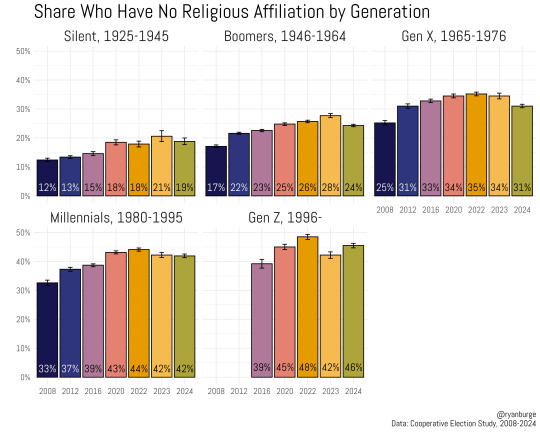
Let me just start with the Baby Boomers. The share of non-religious Boomers grew slowly and steadily over time from 17% in 2008 to 28% in the 2023 data. But look at what this new survey reveals - the share of Boomers who are non-religious is now just 24%. That’s back to the 2018 levels. And that same general trend is there for Generation X, too. They rose from 25% to 35% between 2008 and 2022. But the estimate in 2023 was 34% and it’s down to 31% in the 2024 results. That’s the same percentage as 2012.
For Millennials, it’s basically the same story as Generation X - it’s just that the overall percentages are higher across the board. There was a ten point increase in the nones between 2008 and 2022, but then a two point decline to 42% in both 2023 and 2024. And Generation Z is a weird one because the same 2022 peak is there at 48%, then a big decline - six points in 2023. (For what it’s worth, I thought that it couldn’t be that large and I said so to numerous groups over the last year). Now, the 2024 number is 46%, which honestly makes perfect sense. I would have guessed the real number was around 45%. So this is confirmation to me that 2023 was just a wonky sample for Gen Z.
Let me put the “I am going to take a picture of your slide with my camera” graph right below. This is the one that sort of encapsulates the entirety of religious change in the United States in a pretty succinct way.

To me, this graph really comports well with how I am thinking about things in American religion right now. The first thing to note is that Christianity has just not been doing well in transferring itself down through the next generation - that’s especially true for Protestants. Among the Silent Generation, 47% were Protestants. It was 5 points lower among Boomers, dropped another six points among Gen X, then declined a whopping nine points among Millennials - just 27% of them are Protestants. Gen Z is even worse at only 22% Protestant - a drop of 25 points from top to bottom.
Catholics, on the other hand, look a whole lot more robust. Among Silents, 22% are Catholic. It’s 20% of Boomers, and 18% of Gen X. It's notable that the Catholic percentage seems to have hit a floor - 16% with both Millennials and Gen Z. But overall, about 70% of the Silent Generation are Christians compared to only 38% of Gen Z. Certainly not great news for the Christians who read this newsletter.
Okay - enough about religious belonging. Let me pivot to the other metric that is incredibly relevant - religious attendance.
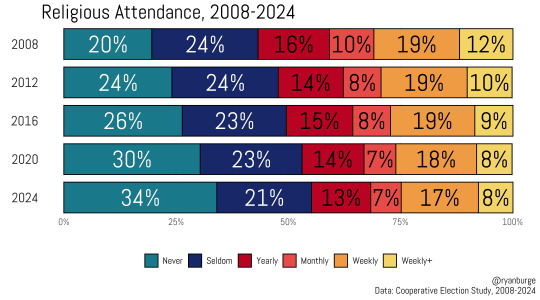
If the headline from this post is that religious belonging may be seeing a glimmer of hope, that enthusiasm is dampened significantly when glancing at this graph. The overall decline in attendance at houses of worship has continued at a pretty steady pace since 2008. In that sample, 44% of folks attended less than once a year while 31% were attending religious services on a weekly basis. It’s been all downhill from there.
In the 2024 data, about a third of the sample said that they never attended religious services. That’s a four-point jump since 2020 and a fourteen-point increase from 2008. Overall, 55% of American adults attend a religious service less than once a year now - that’s an eleven point jump in sixteen years.
What buoys this a little bit is the share of Americans who are incredibly religiously active. Again, it was 31% weekly attenders in 2008 and it was still 28% by 2016. Three points in eight years isn’t that bad really. In the next eight years, it also dropped another three points. Today, a quarter of Americans are weekly attenders. Low-attenders bested high-attenders by 13 points in 2008. In the 2024 result it had ballooned to 30 points. There’s no evidence of any type of revival in this graph.
But, if I break this down into generations, there is a bit more nuance that is worth conveying.
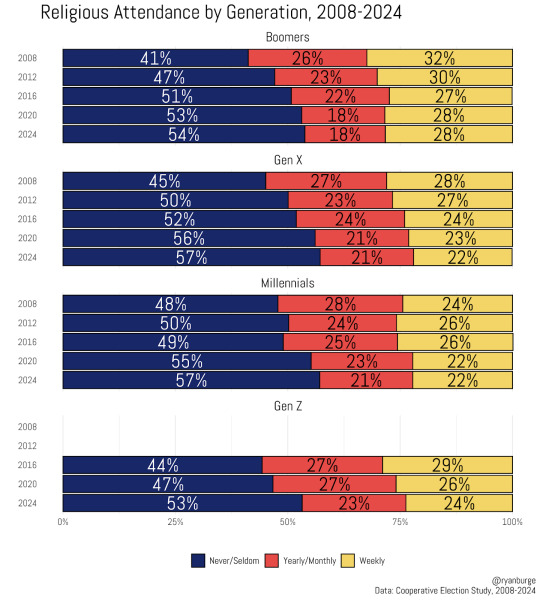
Okay - I think we can all admit that the very low attendance category has gained ground among older Americans and younger Americans, too. The never/seldom percentage is up thirteen points among Boomers, twelve points among Gen X, and nine points among Millennials between 2008 and 2024. Meanwhile the high attending share is down four points, six points, and two points respectively. Read that last sentence again, please. There’s not been a huge drop in the share of each generation that is incredibly religious engaged. Instead it’s a lot of movement from the yearly/monthly group down to the seldom/never bucket. The strong core of highly engaged religious people is still there.
Here’s the other piece of this that I think is a pretty interesting result - the religious attendance of Gen Z is actually pretty robust compared to other generations. In 2024, 24% of Gen Z were attending weekly - that was two points higher than Millennials and Gen X. While 53% of Gen Z are attending less than once a year, that’s actually the lowest percentage of any generation in this analysis. Maybe, just maybe Generation Z is more religiously engaged than their parents or grandparents.
So - there you go. It’s a really mixed bag for Christians who are hoping for a revival. This is most certainly not a catastrophic set of data where the nones have just continued to explode in size and religious activity has fallen off a cliff. But there's also not any evidence at all of “A Great Awakening” or anything like that. Religion seems to have hit a bit of stasis in the last five years.
What comes next? I have no idea. But I’m already waiting for another release of CES data.
==
Hopefully it's just a temporary pause and resumes its downward trajectory.
#Ryan Burge#rise of the nones#religion#decline of religion#leaving religion#empty the pews#no religion#irreligion#religion is a mental illness
4 notes
·
View notes
Text
Unlock Radiant Skin and Healthy Hair with Natural Nourishment Solutions

In the world of skincare and haircare, going natural is no longer a trend—it's a lifestyle. If you're on the lookout for gentle, effective, and nature-powered products, you're in for a treat. From mineral-rich moisturizers to calming chamomile oil, the right solutions are now just a click away.
Start your routine with a nourishing base like the mineral moisturizer. Designed specifically for normal to dry skin, this lightweight formula hydrates while offering SPF 30 protection. It blends mineral-based ingredients that protect without clogging pores, making it ideal for daily use.
Next, treat your skin to deep hydration with an avocado face mask. Packed with honey and avocado extracts, it deeply nourishes, soothes irritation, and leaves your skin feeling refreshed. It's especially great for reviving dull or dry complexions with natural ingredients that your skin will love.
But why stop at skincare? Healthy hair is just as important. For that, explore hair nourishment solutions that infuse your strands with the care they need. Whether you're looking to repair damage or just add a bit more shine, this natural formula delivers results with regular use. Those aiming for truly nourished hair will find it a game-changer in their routine.
Complete your body ritual with body nourish, a luxurious blend crafted to soften and hydrate skin from head to toe. This product locks in moisture and keeps your skin feeling silky smooth throughout the day.
To top it off, indulge in the calming and soothing effects of chamomile oil. Whether you're looking for stress relief or skin healing, German chamomile essential oil brings anti-inflammatory and therapeutic benefits that work wonders.
Embrace the power of natural care with these hand-picked essentials. Your skin, hair, and body deserve nothing but the best.
2 notes
·
View notes
Text
The United States, Ukraine, the European Union, and the Russian Federation have been riding a diplomatic rollercoaster for the past month, with the announced March 18 call between US President Donald Trump and Russian President Vladimir Putin the next turn ahead. Amid the furious pace, chances for a sustainable peace in Ukraine remain very much in question. In particular, the past few weeks have witnessed a flurry of shuttle diplomacy by the Trump administration, with Secretary of State Marco Rubio and National Security Advisor Mike Waltz securing an agreement for an immediate thirty-day cease-fire from top Ukrainian government officials in meetings held in Riyadh. The next step is up to the Kremlin. And so far, Putin seems content to allow progress to slow to a glacial pace.
Putin has effectively—though not yet formally—rejected the US and Ukrainian offer of an immediate thirty-day cease-fire. He is raising conditions untenable for the Ukrainian side and inimical to a sustained settlement while he attempts to claim to be an adherent of “peace.” Far from preparing to halt his unprovoked aggression toward his democratic neighbor, Putin has returned to calls to address the “root causes of the crisis,” by which he appears to mean Ukraine’s independence from Moscow. At the same time, he is publicly lobbying the United States and Europe to abandon Ukraine.
Trump may yet convince Putin to agree to an immediate, unconditional cease-fire. If he does not, the United States should increase pressure to force Putin to the negotiating table and accept terms essential to a sustainable peace, including Ukraine’s long-term security. To start with, the administration should turn up the pressure on the Kremlin via comprehensive sanctions and technology export controls that target Russia’s main economic lifeline: energy exports.
The Trump administration should deploy a “maximum pressure” approach, especially on energy, since Russia’s oil and gas revenues continue to play an outsized role in Moscow’s ability to fund its military aggression in Ukraine. Given the domestic cashflow challenges already plaguing Moscow, a broader swath of energy sanctions and controls on oil field service technologies, if aggressively and comprehensively enforced, could help create the level of pressure required. And the administration has options.
The Trump White House has a wide menu available to continue to mount energy sanctions and restrictions on Putin’s Kremlin, and it appears to have taken the first step toward such a strategy in the past few days. On March 12, the US Department of the Treasury Office of Foreign Assets Control (OFAC) allowed the expiration of a temporary general license that had been provided by the Biden administration for firms to continue to process transactions related to energy purchases with a set of Russian financial institutions. This loophole has been open in various forms since just after Russia’s full-scale invasion began in February 2022, and it is finally (and mercifully) now closed, restricting a key conduit for Russia to financially benefit from its energy exports.
First and foremost, the Kremlin-backed Nord Stream 1 and Nord Stream 2 natural gas pipelines must be a priority for the White House. Headlines related to their possible revival continue to appear, but the Trump administration should work to prevent their reestablishment. One way to do this would be for the White House to issue an executive order levying permanent blocking sanctions against Russian energy export pipelines, such as the pair of Nord Stream and TurkStream projects. These sanctions could also apply to the Yamal-Europe pipeline and other similar Kremlin-backed schemes, as well as Russian liquefied natural gas export terminals and vessels. The United States ought to be seeking to replace Russia on world energy markets, not allowing Russia to come back.
The administration, led by OFAC and the US intelligence community, should also intensify efforts to track, identify, and designate all vessels that are shown to be a part of Russia’s so-called “shadow fleet” of underinsured, sanctions-and-price-cap-busting oil tankers. The push to sanction Putin’s shadow fleet has been underway for some time, but due to the scale of the fleet, enforcement has consistently been behind the curve.
The United States (as well as the European Union and United Kingdom) should impose sanctions on all additional vessels from the shadow fleet that it can identify—and deploy secondary sanctions against ports that receive them. For Russia to replace its sanctioned tankers with new “shadow fleet” tankers through secondary-market purchases would likely take time and resources. Moscow is unlikely to put that much capital at risk, especially if it believes the United States might quickly add those tankers to the OFAC target list as well.
But it’s not enough to go after just the shadow fleet. Should shadow-fleet-tanker listings force Russia to become more reliant on mainstream tankers, Moscow may attempt to defraud those vessels into carrying cargoes priced above the sixty-dollars-per-barrel price cap by continuing to provide fraudulent price attestations. Under the price cap, mainstream tanker owners in the Russia trade are required to receive a price attestation from a trader handling the trade, but not the underlying contracts, which many trading counterparties would refuse to divulge.
To reduce the risk of attestation fraud, OFAC could develop a “white list” of well-established oil traders with high levels of exposure to and legal accountability in the United States. OFAC would then require that mainstream tankers only lift Russian oil if a white-listed trader is handling the sale and providing the price attestation. This would put additional pressure on Russia to sell its oil through white-listed traders when using mainstream vessels.
As another maximum pressure option, the United States could borrow an idea from the sanctions regime on Iran. One of its most aggressive features was the demand, originally in legislation, that Iran’s oil customers reduce their purchases every six months, backed up by the threat of severe financial sanctions, including against the purchasing country’s central banks. The United States could introduce a similar regime against Russian oil sales, keeping in mind the need not to risk a spike in global oil prices by forcing too much Russian oil off the market and, hopefully, in coordination with other oil producers, such as Saudi Arabia.
These energy sanctions could be coupled with additional financial sanctions. The United States and Europe acted gradually to impose financial sanctions on Russia’s big state banks and some private banks, along with sectoral sanctions on technology and some Russian companies. This creates a complex sanctions regime in which some trade and finance is banned but much remains allowed, with gray areas and loopholes. The United States, acting with Europe, should consider a general financial embargo and even a trade embargo on Russia, with specified categories of permitted trade and related finance, such as medicine, limited energy, food, and other transactions. In addition, sanctions on high-tech energy and other technologies—especially those that could be repurposed to support Russian military supply chains—should be deepened to the greatest extent possible, backed up with the threat of secondary sanctions.
To help with all this, the Trump administration should significantly scale up executive branch staffing on sanctions monitoring, targeting, and enforcement through a reallocation of existing personnel or external hires. Additionally, the administration should foster public-private partnerships with commercial satellite imaging companies to allow the United States’ academic and expert communities to build on US government capacity to track and identify Russia’s shadow fleet. Moreover, these vessels should be designated under existing sanctions authorities.
The White House need not act alone here—statutorily mandated sanctions always send a stronger message than executive orders. Therefore, the US Senate Foreign Relations Committee and Banking Committee can play a big role in showing an all-of-government pressure campaign is in the offing against the Kremlin. Senator Lindsey Graham’s proposed “bone-breaking” Russia sanctions package is one of many strong signals that demonstrate that Congress is willing to strengthen the US push for a sustainable peace in Ukraine. Furthermore, the White House should capitalize on some European leaders’ warming attitude toward increasing Russia sanctions as well as seizing and using frozen Russian central bank assets to support Ukraine’s ability, even after a cease-fire, to rebuild and rearm in the face of what is likely to be sustained Russian pressure regardless of an agreement to halt fighting in Ukraine.
In other words, by wielding the sanctions sticks the White House, Congress, and European allies already hold, the Trump administration can bolster Ukrainian military resolve and its own policy of seeking an end to the war on favorable terms.
Otherwise, Putin will simply push to have his carrot cake and eat it too.
18 notes
·
View notes